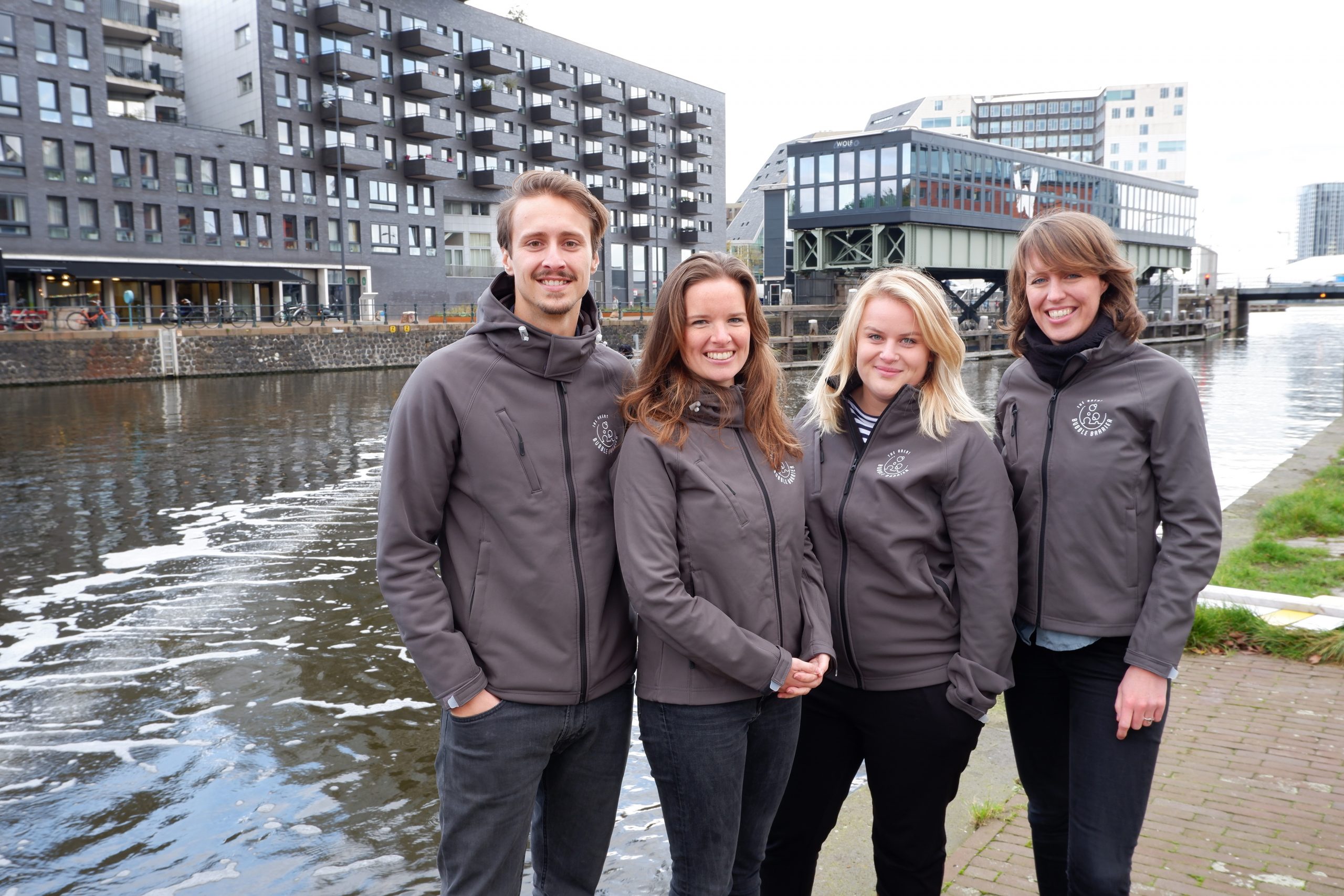
Eight billion kilos. That’s about how much plastic ends up in the ocean every year. 80 % of all that plastic ends up into rivers via the land and flows straight out to sea. In order to reduce the amount of plastic soup in the sea, Boyan Slat set up The Ocean Cleanup in 2013. But what if you can capture that plastic before it reaches the ocean? Anne Marieke Eveleens, Saskia Studer, Francis Zoet and Philip Ehrhorn came up with this idea. Together they set up The Great Bubble Barrier. A screen made up of air bubbles in rivers that intercepts plastic and doesn’t let it through. In November 2019 the start-up placed the first installation in the Westerdok (dock) in Amsterdam. Innovation Origins spoke with Sandy Reitsma from The Great Bubble Barrier.
An air bubble screen, how does that work?
” A tube with holes in it where air is pumped through is placed at the bottom of a river. This creates a wall of air bubbles that causes plastic to rise and float to the water’s surface. Natural flow of the waterway and the diagonal placement guide the blocked plastic to the collection system at the dock. This works 7 days a week, 24 hours a day. While fishing and shipping are not affected.”

Perhaps an unnecessary question, but what problem do you want to resolve?
“The plastic problem is huge and is damaging ecosystems all over the world. Fortunately, there are already a number of initiatives that are working towards cleaner oceans and rivers. Except a lot of plastic in rivers isn’t visible because it floats under the surface of the water. This now floats to the surface because of our system. We literally make the plastic problem visible. With our installations we not only prevent plastic from ending up in the ocean via rivers, but we also try to make people reflect on their use of plastic. Naturally, we would prefer to get rid of plastic altogether”.
How much plastic does a bubble screen collect?
“We installed our first long-term installation last November at Amsterdam’s Westerdok in collaboration with the Amstel, Gooi and Vecht Water Board and the municipality of Amsterdam. We now want to monitor the harvested plastic for a year so that we can say how much we’ve collected across all seasons.”
How did the idea come about?
“Anne Marieke Eveleens, Saskia Studer and Francis Zoet are all sailors. They noticed how much plastic is floating around in Dutch rivers and they wanted to do something about it. While drinking a beer they noticed that beer bubbles rise up to the surface. So the idea of a bubble screen literally just bubbled up. The first pilot was held in 2017. A year later they won the Dutch Postcode Lottery Green Challenge competition. Around that time Philip Ehrhorn from Germany, who had a similar idea, also came on board. With the prize money of half a million euros, the ball started to roll and research and subsequent pilot projects could be set up. We are now a company of 10 people.”
Why do you think it is that many young entrepreneurs want to set up something to make the world a better place?
“I think it gives more satisfaction to be able to set up something that benefits the world. There’s plenty going on in the world, insects are dying out, plastic oceans, growing social divides and air pollution. You can then do two things: ‘business as usual’ or challenge that and try to do something about those problems. We are in a purpose era, we want to contribute something positive to society. I think it’s mainly millennials who are driving this.”
But as a start-up, money is also important, is that ever a sore point?
“You see that there are more and more lucrative business ideas emerging which are concerned with the world’s problems. Funding is always a challenge as a start-up. In our case, we are dependent on municipalities, water boards, government agencies or other partners. We are constantly working on creating consensus, we have to inspire confidence and demonstrate that our product works.”
 The first installation in Amsterdam’s Westerdok © The Great Bubble Barrier
The first installation in Amsterdam’s Westerdok © The Great Bubble BarrierWhat has been your proudest moment?
“Without a doubt the launch of our first installation. We all worked incredibly hard months in advance to get it done. That it turned out so well is really cool. Even the fact that we couldn’t have had any worse weather at the official launch – cold, rainy and dark – made no difference whatsoever. It’s unbelievable how much media attention we got after this, really from all over the world. From Spain to Korea. It was a busy period where we were able to spread our idea, that’s why you do it all.”
What can we expect from you in the near future?
“Right now we’re scaling up our product, we’re always looking to improve things. We are in talks with both Dutch and foreign parties. We want to install several installations over the coming period that will tackle the plastic problem.”

